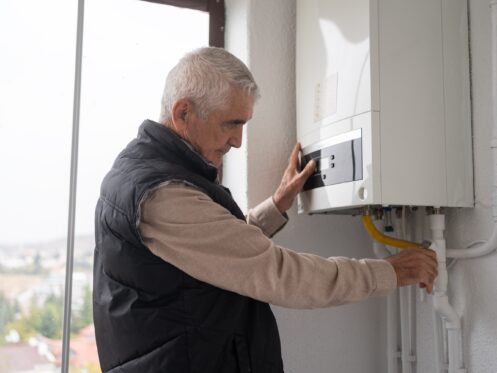A real estate plumbing inspection is one of the most important steps to consider when buying a house. A big part of the integrity of the plumbing system forms a core part of the functionality of any home, and failures therein are huge and involve expensive problems if not foreseen.
A detailed plumbing inspection is crucial for gaining insights into the condition of your plumbing system and for predicting potential issues before they escalate into major problems. By understanding the state of your plumbing infrastructure, you can make informed decisions about the property and effectively negotiate repairs or price adjustments with the seller.
1. Identify Hidden Problems
A plumbing inspection reveals problems that are not immediately visible, such as internal leaks or damaged pipes. At Cal’s Plumbing, we use specialized tools to detect issues within walls and under floors. We assess the condition of components like fittings and joints that may have deteriorated over time. Early detection prevents small issues from becoming major repairs. For instance, a minor leak could cause significant water damage if left unchecked.
An inspection provides a comprehensive view of the entire plumbing system’s health. Identifying problems early helps in making an informed decision about the home. Without this inspection, these issues might go unnoticed until they cause substantial damage or require costly repairs. This proactive approach ensures that you’re aware of any underlying problems before you commit to purchasing the property.
2. Outdated Pipes
Plumbing systems with outdated pipes can lead to various problems, including leaks and reduced water pressure. Our inspectors evaluate the type and condition of the pipes used in the home. We identify materials that may be prone to corrosion or deterioration, such as galvanized steel or polybutylene. Replacing these outdated pipes often requires significant work and expense.
Knowing the status of the pipes helps you plan for potential upgrades or repairs. For instance, modern homes benefit from pipes made of PEX or copper, which are more durable and efficient. The inspection can reveal if the existing pipes need replacement or if they comply with current building codes. This information allows you to factor in any necessary plumbing updates when assessing the overall value of the home.
3. Check for Leaks and Water Damage
Our inspectors look for signs of leaks, which can cause water damage to walls, floors, and ceilings. They use tools to detect hidden leaks behind walls and under floors, where they might not be visible. Identifying these leaks early prevents further damage that could lead to expensive repairs or structural issues. Water damage can affect the integrity of the home’s structure and lead to problems such as wood rot or compromised insulation.
Inspectors also assess areas prone to leaks, like around fixtures and pipes. By detecting leaks before purchasing, you can address these issues with the seller or budget for necessary repairs. This proactive approach helps ensure that the home remains in good condition and avoids unforeseen costs after moving in.
4. Inspect the Water Heater’s Condition
The water heater is a critical component of the plumbing system, and its condition affects overall home functionality. We examine the water heater for signs of wear, corrosion, and inefficiency. We also check for leaks, sediment buildup, or issues with the thermostat and heating elements. An outdated or faulty water heater can lead to inconsistent water temperature and higher energy bills.
Replacing or repairing a water heater can be a significant expense, so knowing its condition helps you plan accordingly. The inspection also ensures that the water heater meets safety standards and is up to code. Evaluating the water heater before purchasing the home provides insight into potential future costs and helps ensure reliable hot water for your daily needs.
5. Catch Sewer Line Issues
Sewer line issues can lead to significant and costly repairs if not identified early. We can use specialized cameras to inspect the condition of the sewer lines and identify potential problems such as blockages, cracks, or tree root intrusions. We can also assess the overall integrity of the sewer system and its connections to the home. Problems with the sewer line can cause backups and unpleasant odors and even damage the foundation.
Early detection allows you to address these issues before they escalate. Understanding the state of the sewer lines helps you make informed decisions about repairs or negotiations with the seller. This proactive approach prevents future headaches and ensures the home’s waste management system functions properly.
6. Identify Incorrect Installations
Plumbing systems must adhere to current building codes and standards. Our inspectors check for installations that do not meet these requirements, such as improperly installed fixtures or non-compliant pipe layouts. Incorrect installations can lead to functionality issues and safety concerns. For example, incorrect venting of a sewer line can cause foul odors or health risks.
Identifying these issues before purchasing the home allows you to address them with the seller or budget for necessary corrections. Ensuring that all plumbing installations comply with current codes helps avoid future regulatory problems and potential fines. This thorough examination ensures that the home’s plumbing system operates correctly and adheres to safety and quality standards.
7. Water Pressure and Flow Test
Water pressure and flow are crucial for the functionality of the plumbing system. Our inspectors measure water pressure at various fixtures to ensure it meets acceptable levels. Low water pressure can indicate underlying issues such as clogs or pipe damage. We also assess water flow rates to determine if the system provides adequate volume for daily use.
Problems with water pressure or flow can affect the comfort and convenience of using the home’s plumbing. Understanding these factors before purchasing allows you to address any issues or make adjustments as needed. Evaluating water pressure and flow ensures that the plumbing system will meet your needs and function efficiently after you move in.
8. Avoid Expensive Repairs
Early detection of plumbing issues through an inspection helps avoid unexpected repair costs. Identifying problems before purchasing the home allows for proactive repairs or negotiations with the seller. Plumbing issues that go undetected can lead to larger, more expensive repairs over time. Addressing these issues early can save you money and prevent additional damage.
For instance, fixing a minor leak now is less costly than dealing with extensive water damage later. The inspection report provides a clear picture of the plumbing system’s condition, helping you budget for repairs or upgrades. This foresight prevents surprises and helps manage overall home maintenance costs effectively.
9. Negotiate Repair Costs
Discovering plumbing problems during an inspection provides leverage for negotiating repair costs with the seller. Knowing the extent of the issues allows you to request repairs or a reduction in the purchase price. This negotiation can help offset the costs of addressing identified problems.
If an inspector finds significant issues with the water heater, you can ask the seller to cover the replacement costs or reduce the sale price accordingly. Effective negotiation ensures you don’t have unreasonable financial burdens by unforeseen repairs after purchasing the home. The plumbing inspection results serve as a basis for these discussions, enabling a fair and informed negotiation process.
At Cal’s Plumbing in Tucson, AZ, we provide plumbing installation, backflow prevention, and water leak detection services for homes in the area. Our friendly team also provides water conditioners, water softeners, and water purification services. Contact Cal’s Plumbing for more information today!






